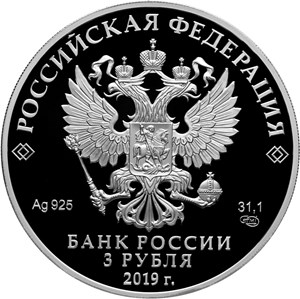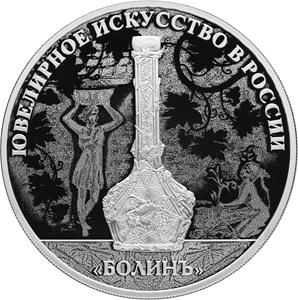Jewellery Items of the Firm of Bolin
Obverse
the mirror field of the disc bears a relief image of the National Coat of Arms of the Russian Federation, over it along the rim there is the semicircular inscription "РОССИЙСКАЯ ФЕДЕРАЦИЯ" (RUSSIAN FEDERATION) framed on both sides by doubled rhombuses, below under the coat of arms there are indications of the precious metal and its fineness on the left and the fine metal content and the mint trade mark on the right, at the bottom in the centre, in three lines, there is an inscription "БАНК РОССИИ" (BANK OF RUSSIA), the denomination of the coin "3 РУБЛЯ" (3 RUBLES), and the year of issue "2019 г." (2019).
Reverse
there is a relief image of a jewellery item made by Bolin – a silver-mounted crystal pitcher with a stylised composition themed on other items of the firm in the background; there are inscriptions: ‘ЮВЕЛИРНОЕ ИСКУССТВО В РОССИИ’ (JEWELLERY ART IN RUSSIA) at the top along the rim and ‘БОЛИНЪ’ (BOLIN) at the bottom.
Authors
The artists: E.V. Kramskaya (obverse), A.A. Brynza (reverse).
The sculptors: A.A. Dolgopolova (obverse), A.N. Bessonov (reverse).
Discover more
The House of Bolin is a jewellery firm that operated in Russia from the early 19th century to 1917.
The firm’s history started in 1790 when a diamond master Andreas Roempler arrived in Saint Petersburg from Saxony and received a title of the court's jeweller of the emperor Paul I. Later, his daughters married jewellers Gottlieb Ernst Jahn and Carl Edvard Bolin who continued Roempler's business and established the firm Bolin & Jahn. The firm became world-famous after its success at the Great Exhibition of 1851 in London. Carl Bolin became the court’s jeweller, and the jewellery house, which passed to his sons after his death, retained this title. In 1871, Edward Ludwig Bolin, one of Carl Bolin’s sons, established Bolin C.E. trade house and was considered one of the three leading Saint Petersburg’s jewellers along with Friedrich Kehli and Carl Faberge.
The firm specialised in expensive and unique jewellery items made of diamonds, pearls and massive gems for wives of Russian emperors.
The firm also had a branch in Moscow managed by Carl Bolin's nephew Wilhelm. The branch specialised in manufacturing silver- and crystalware: kitchenware, pitchers, vases, etc. It is mainly this branch's products that have survived until today.
Mint: Saint Petersburg Mint (СПМД). The edge: 300 corrugations.


